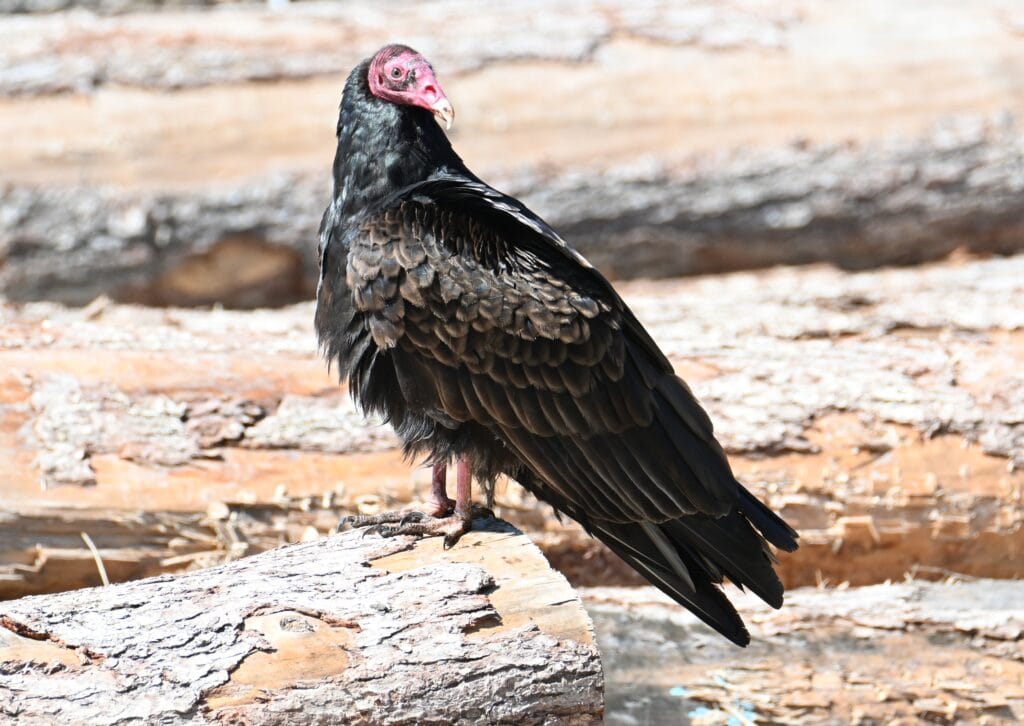Some birds, like the Giant Petrel, develop a rough reputation based on their behavior and appearance. The Giant Petrel is a ferocious hunter with a somewhat forbidding look. Others, like the Loggerhead Shrike, develop a wicked reputation in spite of appearances. This relatively cute songbird is known for its brutal hunting habits. Then, there’s the Turkey Vulture; a bird whose rough exterior and unappetizing diet has inspired a completely unearned reputation as a bad omen and a tough customer.
The Turkey Vulture is neither. This bird’s large size, dark plumage and bald pink head might be “creepy” to some, but look a little deeper and the Turkey Vulture is both fascinating and beautiful. These birds are key participants in the natural cycle of life within their home range, which spans much of the Americas. They are underappreciated and unjustly maligned.
Related Article: American Birds Named After People Will Be Renamed
Fun Facts About the Turkey Vulture:
When it comes to rehabilitating the Turkey Vulture’s unearned negative image, step one is education. That’s why I’d like to introduce you to some of the reasons why I admire the Turkey Vulture. Let’s dive in!
The nose knows: The Turkey Vulture is well-known for its diet of carrion. In fact, much of the reason that people see these birds as “bad omens” is because of their connection with death. Some people think that Turkey Vultures nearby is a predictor that something will die soon, but Turkey Vultures don’t really use clairvoyance to find their food. Instead, they have an incredible sense of smell. Most birds don’t smell very well. If you’ve ever heard someone say not to touch a baby bird because its parents will smell humans and reject it, this is generally false — though leaving baby birds alone is pretty good advice. Most birds use sight to hunt or forage. The Turkey Vulture, though, is one heck of an exception. These carrion-eating raptors can smell the gases released from decaying bodies from over a mile away. This is due to both specialized nostrils and an oversized olfactory bulb in the brain. Though you might associate these birds with rot, they tend to prefer relatively fresh carcasses. Once meat begins to smell foul to humans, Turkey Vultures are less likely to choose it.
Purifying breeze: With all this talk or decay and rot, it might come as a surprise to you that the Turkey Vulture’s scientific name, Cathartes aura, means “cleansing wind” or “purifying breeze.” This might not make sense at a glance, but the Turkey Vulture’s role in the food chain certainly matches this. Turkey vultures remove carcasses from the environment, eating them before they can rot and spread diseases. This is a vital function that contributes to the cleanliness of the environment. Though they might seem ominous, a gathering of Turkey Vultures near a recently deceased animal is a good sign that the ecosystem is functioning as intended and nutrients are being quickly and cleanly recycled back into the cycle of life. Because of their strong stomach acid, they can even digest things that would be toxic to most animals, including meat tainted with rabies, anthrax, or tuberculosis. This means that they remove harmful toxins from the environment.
Turkey head and turkey feet: Some find the Turkey Vulture’s bald head and sharp raptor bill to be unsettling, but they both serve an important purpose. Like other New World vultures, Turkey Vultures lack head feathers to so that their heads are easier to keep clean. This is an important sanitary feature for an animal that plunges its face into carrion at every meal. Even if they look creepy to you, Turkey Vultures are truly harmless. In fact, they are the only scavenger birds that do not kill at all. One look at their feet and it’s easy to see why. Unlike other raptors, Turkey Vultures have flat feet like that of a chicken or a turkey. They can’t pin prey with such feet and they don’t have a particularly strong grip. That’s why their bill needs to be sharp for ripping up carrion. The only truly intimidating defense mechanism that Turkey Vultures employ is regurgitating their food at approaching threats. For an animal that eats carrion, this can be an unpleasant experience and a very effective deterrent.
The Future of the Turkey Vulture
Fortunately, in spite of their negative perception by some humans, Turkey vulture populations are thriving. They are listed as being of “Least Concern” by the IUCN Red List of Threatened Species and their adaptable nature has allowed their populations to remain quite stable throughout much of their range.
Popular Article: Parakeets Have a “Vocal Fingerprint” That Others Recognize

